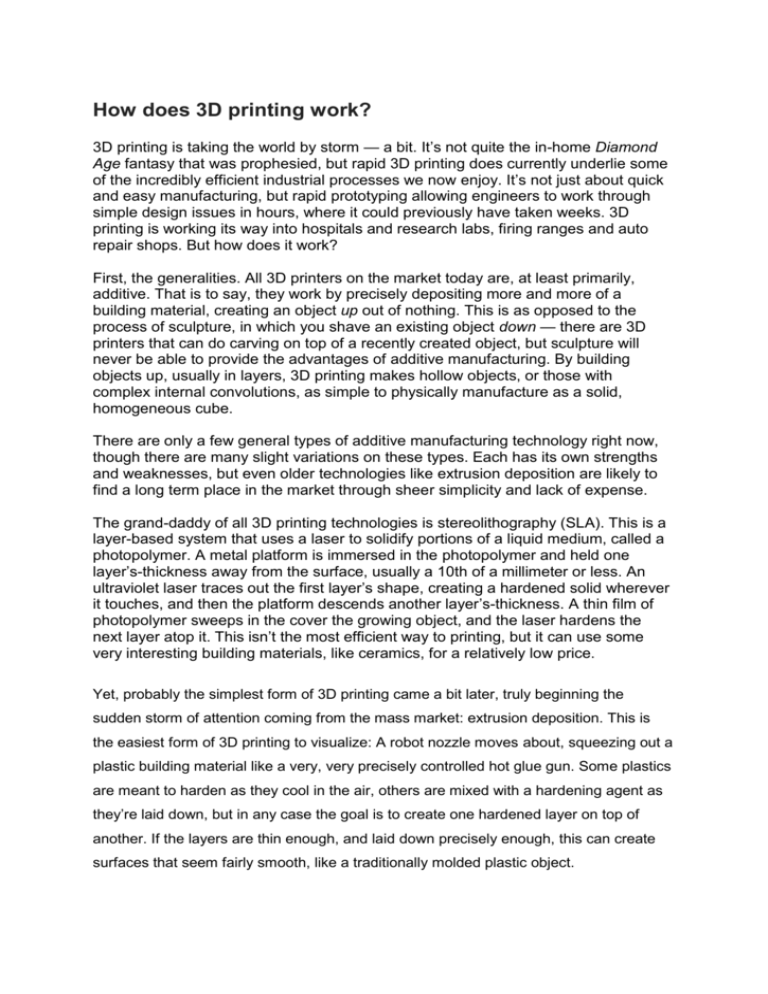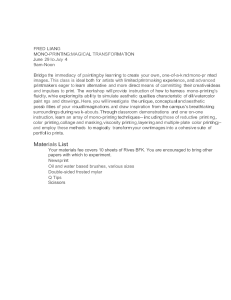How does 3D printing work?
advertisement

How does 3D printing work? 3D printing is taking the world by storm — a bit. It’s not quite the in-home Diamond Age fantasy that was prophesied, but rapid 3D printing does currently underlie some of the incredibly efficient industrial processes we now enjoy. It’s not just about quick and easy manufacturing, but rapid prototyping allowing engineers to work through simple design issues in hours, where it could previously have taken weeks. 3D printing is working its way into hospitals and research labs, firing ranges and auto repair shops. But how does it work? First, the generalities. All 3D printers on the market today are, at least primarily, additive. That is to say, they work by precisely depositing more and more of a building material, creating an object up out of nothing. This is as opposed to the process of sculpture, in which you shave an existing object down — there are 3D printers that can do carving on top of a recently created object, but sculpture will never be able to provide the advantages of additive manufacturing. By building objects up, usually in layers, 3D printing makes hollow objects, or those with complex internal convolutions, as simple to physically manufacture as a solid, homogeneous cube. There are only a few general types of additive manufacturing technology right now, though there are many slight variations on these types. Each has its own strengths and weaknesses, but even older technologies like extrusion deposition are likely to find a long term place in the market through sheer simplicity and lack of expense. The grand-daddy of all 3D printing technologies is stereolithography (SLA). This is a layer-based system that uses a laser to solidify portions of a liquid medium, called a photopolymer. A metal platform is immersed in the photopolymer and held one layer’s-thickness away from the surface, usually a 10th of a millimeter or less. An ultraviolet laser traces out the first layer’s shape, creating a hardened solid wherever it touches, and then the platform descends another layer’s-thickness. A thin film of photopolymer sweeps in the cover the growing object, and the laser hardens the next layer atop it. This isn’t the most efficient way to printing, but it can use some very interesting building materials, like ceramics, for a relatively low price. Yet, probably the simplest form of 3D printing came a bit later, truly beginning the sudden storm of attention coming from the mass market: extrusion deposition. This is the easiest form of 3D printing to visualize: A robot nozzle moves about, squeezing out a plastic building material like a very, very precisely controlled hot glue gun. Some plastics are meant to harden as they cool in the air, others are mixed with a hardening agent as they’re laid down, but in any case the goal is to create one hardened layer on top of another. If the layers are thin enough, and laid down precisely enough, this can create surfaces that seem fairly smooth, like a traditionally molded plastic object. If we want to do printing with ever-more-study and -diverse materials, things like high strength metal, we’re going to need something better than a super-advanced hot glue gun. Selective laser sintering (SLS) has been the primary answer, thus-far. This approach involves releasing a tiny cloud of your building material in an aerosol form, a small puff spit out over the area we’re trying to build up. A precisely-timed laser blast then fuses these individual molecules of building material, usually metals, to the growing object. An even more advanced version of this technology called Selective Laser Melting (SLM) works in much the same way. Rather using the laser to fuse additional molecules to a growing object, SLM machines completely melt their particles of building material, essentially building from tiny speck of molten metal and potentially creating much stronger and denser final materials. Then, there are the more specialized forms of printing. One example is carbon fiber, which can be used to print high-strength parts with low density. These sorts of specialized and composite building materials still require entry to the high end of the price spectrum — but not necessarily the extreme high-end. For well just over $5,000, an enthusiast can print in carbon fiber parts that are, in most ways, better than those printed in metal. It’s all, finally, starting to hit the real world. Aviation companies like Airbus is now producing thousands of cheap, light-weight parts for their jets with 3D printing, while medical professionals can now quickly produce molded casts and prostheses for patients. Most design firms have at least a cheap little 3D printer sitting on a desk somewhere, so they can quickly pick up an idea and look at it from all angles. It’s a testament to the versatility of additive manufacturing that it’s being used even by enthusiasts for all sorts of interesting purposes. People are making working firearms. They’re printing functional replica musical instruments.This guy has even made a huge belt-based printer aimed at making full-scale pieces of corporate art from, basically, solder. The efficiency of 3D printing is also perfect for the high-end science crowd. So-called bioprinting could revolutionize the growth of organs from stem cells, as new printers can build a matrix of stiff polymer laced with nutrients and the appropriate stem cells. This allows organs to grow as organs, structured three-dimensional objects, rather than homogeneous lumps of organ tissue in a petri dish. SLS and SLM have both been used by NASA to create mission-ready parts for real launches. The goal, long term, is to be able to 3D print entire complex missions, perhaps even in space. There have been attempts to print in glue mixed with moon- or Mars-dust, potentially allowing a lander to autonomously build structures for later human colonists. There’s even an initiative called SpiderFab aimed at 3D printing large structures right in the vacuum of space. We can now start to print soft robots, and even start making objects dynamic over time. The number of possible applications for 3D printing is truly dizzying. Like neural networks, it’s one of those technologies that can change the world without you even noticing it happen. If the vast majority of the printers remain behind the curtain, in factories and labs around the world, then their impact could only ever be felt in the steadily increasing quality of life, and a steadily decreasing cost of living. Check out our ExtremeTech Explains series for more in-depth coverage of today’s hottest tech topics.






